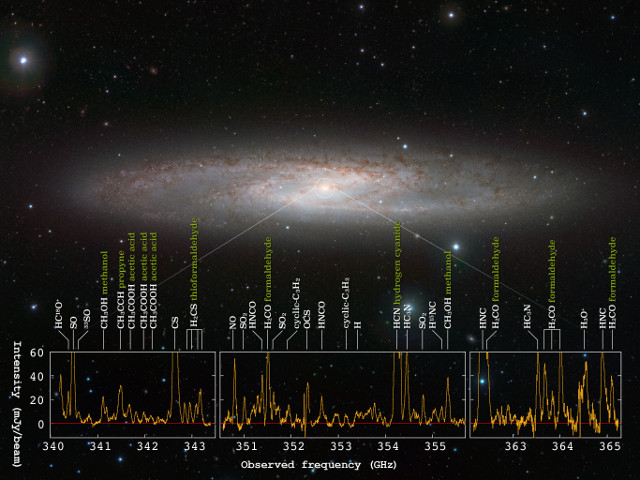
An article published in “The Astrophysical Journal” describes the discovery of 8 molecular clouds within the galaxy NGC 253 in which 19 different complex molecules have been identified. A team of researchers led by Ryo Ando of the University of Tokyo used the ALMA radio telescope to detect the “signatures” of those molecules including thioformaldehyde, methanol, acetic acid, hydrogen cyanide, propyne and other organic molecules, the first detection of that kind outside the Milky Way.
The NGC 253 galaxy has an estimated distance of nearly 11.5 million light years from Earth. It’s a starburst spiral galaxy, which means that there’s an intense star formation inside it. In order to better understand this great activity, Ryo Ando’s team looked at NGC 253 exploiting the great power and sensitivity of the ALMA (Atacama Large Millimeter/submillimeter Array) radio telescope, inaugurated in March 2013.
The researchers found close to the center of the galaxy NGC 253 a total of 8 molecular clouds, the nurseries where star formation activity is concentrated. They have a size around 30 light years each allowing to focus the observations and find out their detailed structure. There are various molecules emitting radio waves and can be identified by their frequencies, shown in the image along with them.
This characteristic revealed the richness of clouds examined with the presence of molecules such as formaldehyde, hydrogen cyanide, and various organic molecules. The clouds are similar in size and mass and are relatively close to each other but the researchers realized that there are clear differences in their compositions.
A cloud in particular revealed a remarkable variety with the identification of 19 complex molecules inside it such as thioformaldehyde, propyne and organic molecules such as methanol and acetic acid. This kind of variety was identified in the Milky Way but it’s the first time it’s discovered in another galaxy.
According to the researchers, this molecular jungle is an aggregate of dense and warm cocoons around newborn stars. The gas of these cocoons is heated from within by hundreds of young stars and the consequence is a large amount of chemical reactions that ends up forming various complex molecules.
This discovery is interesting to understand the processes underway in starburst galaxies, which evolve very quickly with a stellar formation at very high rates. The presence of so many complex molecules where very likely new solar systems formed also offers intriguing possibilities for “seeding” planets and contributing to the birth of new life forms.

